Crystal, second from left, leads a prayer circle around Stephanie's Hamilton Medical Center bed as they wait for her baby girl to be born. Trevor Beebe, right, is head of a club for bikers recovering from addiction. When all goes well, recovering addicts become a surrogate family as they journey through rehab.
Soul Searching
Being female makes rehab a more difficult road to recovery from addiction
By Lynda Edwards
Photography by Angela Lewis Foster
DALTON, GA. — The Rainbow Wash House has been transformed into a picture-perfect baby shower. Pink and green balloons dangle from ceiling and walls. A buffet table is loaded with pastel-colored tea cakes, strawberry punch, pistachio ice cream and miniature croissant sandwiches.
The defunct strip mall coin laundry occasionally is used as a safe-party venue for residents of the Carter Hope Center, an alcohol and drug rehab center and, for this special occasion they have been allowed to invite family members, but only a handful of relatives show up. They flock to the buffet centerpiece — a watermelon carved into a baby buggy with pineapple-ring wheels and a cantaloupe baby head perched above a blanket of honeydew mini-balls.
This is the first time in years that some of the guests have socialized — sober — with others from the opposite sex, but the flirtations are as demure as a church social. Then another female rehab patient offers what she considers an icebreaker: "Now would be a good time for me to read my poem about death being like my most-loyal boyfriend."
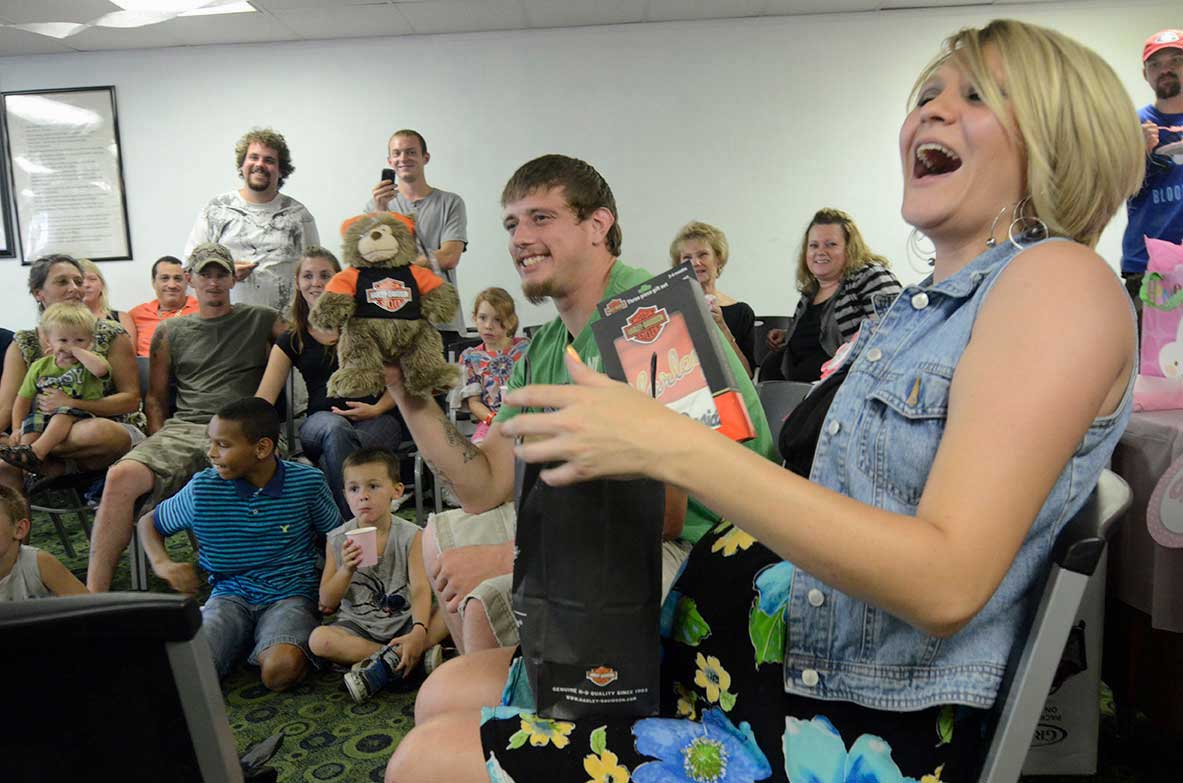
Stephanie, right, and Justin hold up a Harley Davidson gifts that Trevor Beebe gave them at their baby shower in Dalton, Ga.
Before the small group chatting with her can respond, the room erupts with applause as the guest of honor, Stephanie, and her high school sweetheart, Justin, move to the front of the room to open gifts.
Stephanie is seven months pregnant, six months clean and sober. At 24, she looks like America’s most wholesome girl next door: blonde and fit with an infectious smile; many say she is a dead ringer for actress Cameron Diaz. Justin, 22 and also six months sober, fathered all her children: 5-year-old Landon, twin 2-year-old boys (whose names she prefers not to disclose) and daughter Journey, due next month.
Except for Journey, they don’t have their children at the moment. The children were put in foster care about a year ago after Stephanie enlisted a drug-addicted relative to babysit Landon while she partied. The relative had both drugs and Landon in his vehicle when police stopped him for speeding.
Landon is now with loving foster parents, and the twins are with an equally devoted foster family. But Stephanie wants to be a good mother and make a happy home of her own for the children. To convince the Georgia Division of Family and Children Services to give her kids back, she must complete the nine-month rehab without relapse, find a job, rent an apartment, take parenting classes and pay child support to Children Services while in rehab.
This particular day, she also had a much more modest hope: That her children would be allowed by their case workers to attend the party. The case workers said "No." When Leigh, another mother in rehab, greets her 5-year-old son at the party (Leigh’s mother brought him), Stephanie smiles but her eyes well with tears.
Stephanie hopes to earn an early graduation from Carter Hope to care for Journey. Her Plan B is for a cousin who never had an addiction problem to care for the newborn while Stephanie completes her last four months of rehab.
"It was hard finding someone in my family who had no drinking problems ever," Stephanie sighs. "My mom has been sober for years, but Children Services took me away from her when I was a kid because she was addicted."
Before the baby shower, Stephanie registered for gifts at Kmart and Wal-Mart. Trevor Beebe, the head of a bikers’ rehab support group, smiles shyly as she opens his gift, a wee teddy bear wearing a Harley-Davidson hoodie. While everyone is ooooing and ahhhing over the adorable toy, the woman with the poem pulls two friends and a visitor to the back of the room and starts reciting what she’s calling "Mr. Death."
"Mr. Death is my most loyal boyfriend;
He brings needles and booze instead of candy and flowers.
Mr. Death sits in my bedroom all the night hours;
When I wonder if I will ever have a friend,
Or if my children will ever love me.
Because all the family and friends I hurt hate me.
Mr. Death coughs in the dark to remind me.
Mr. Death is always waiting to have a drink with me."
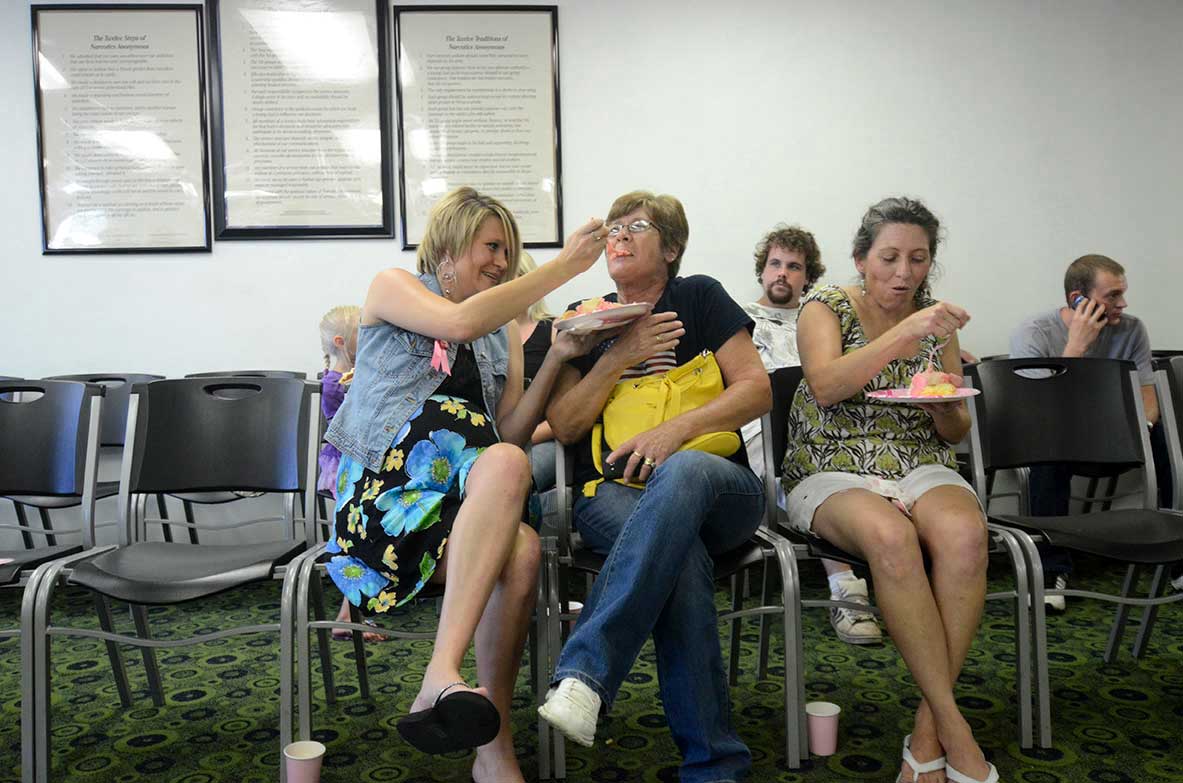
Stephanie, left, feeds her grandmother, Charlotte, a bite of cake as her mom, Tammy, eats at Stephanie's baby shower in Dalton, Ga.
Her friends nervously ponder whether the poem is healthy sharing or a buzzkill. Being sober is so foreign to them, they’re not sure what is and isn’t appropriate in the normal world. They all have trouble with boundaries and impulse control. They have trouble with men. They have problems with their families and problems with children. They have had problems with booze, meth, coke, heroin, weed, oxies and doxies and every other opiate painkiller.
The 11 females at the baby shower are trying to learn some crucial life lessons while in rehab at two cottages that serve as group homes for the nonprofit Carter Hope Center, an old white mansion with a huge curve of wraparound porch perched atop a hill. Many of the 35 male patients live inside the building; the two bungalows that house the women are nestled against the foot of the hill.
You can’t just show up at Carter, live there and get clean. There are rules, duties. All patients must find jobs; each pays $150 weekly for rent, groceries, utilities, Internet and health care. Patients must attend group sessions — staff refer to them as self-help rather than therapy — and keep a workbook as they progress through the 12-step program of Alcoholics Anonymous.
One rule in particular, however, will get several women banned for breaking it during their time in the center: Anyone in rehab must report another patient if she is suspected of using or possessing drugs or having sex with another patient. And any patient who has such suspicions and fails to report them also can be expelled, although counselors examine the circumstances before making a decision.
Counselors in other rehab programs think the rule against sex seems a bit harsh, but they agree with the premise. Rationalization and enabling are so ingrained in an addict’s life, it’s easy for a romance with another addict to ricochet from helping each other get clean to reassuring each other it’s OK to have a drink, one blunt, one hit from a pipe, just this once, just to take the edge off a rough day.
“We aren’t heartless; we allow a person a mistake and don’t hound them if they fall behind in rent,” says Carter Director Chuck Smith. “But my heart breaks when I get a phone call from an addict who needs to be in rehab because she might not make it through another day and I don’t have room for her.”
“If people aren’t committed to the program, they need to leave so people who want to change their lives can be here.”
But even the women who want to be here face more than an addict’s usual herculean task to be clean and sober. Their own lives indicate what many recent studies document: Women experience alcoholism very differently from men.
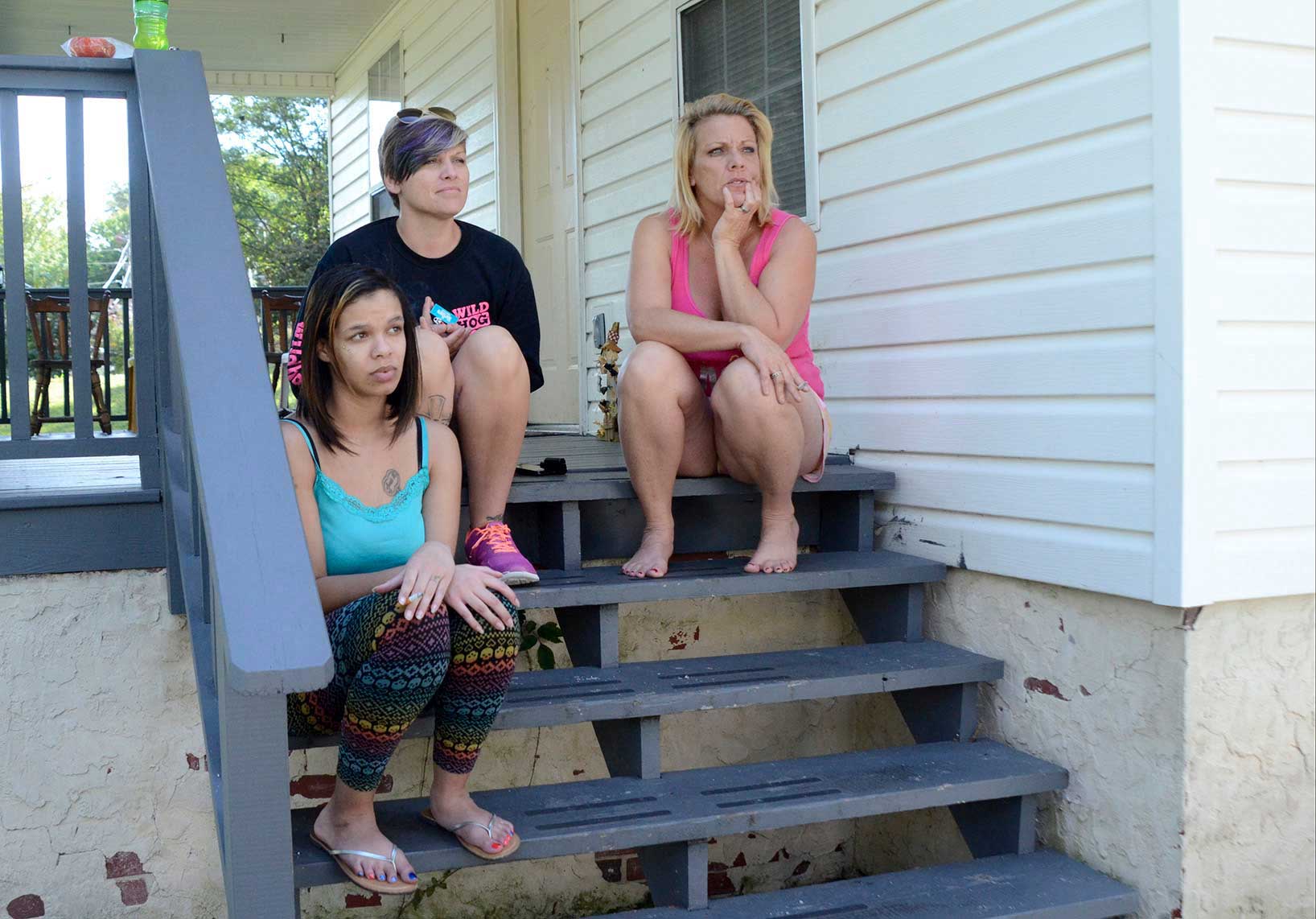
Dominique, Brooke and Crystal sit on the steps of the Carter Hope Center.
“Iron Man” star Robert Downey and “24” TV hero Keifer Sutherland suffered highly publicized alcohol and drug addictions with multiple relapses. Yet their status as sexy bad boys seemed enhanced.
By contrast, actress Lindsay Lohan and singer Whitney Houston were dismissed as career jokes after their substance abuse became public. After her death, singer Amy Winehouse was mocked across cyberspace as an addicted loser even after the official toxicology report concluded that she died from lung disease.
“That’s not just Hollywood; Americans tend to have the same bias whether the alcoholic woman is a lawyer or a sales clerk if their drunken mishaps are public,” says Ann Pingenot, a psychiatric nurse at the University of Tennessee at Chattanooga with an expertise in addiction treatment. “Alcoholism isn’t pretty. It isn’t ladylike.”
Meanwhile, it’s increasingly urgent for female alcoholics to get help. The number of U.S. females who died from cirrhosis of the liver between 2002 and 2012 rose 13 percent; but male cirrhosis deaths rose only 7 percent in the same decade, according to a survey from the U.S. Substance Abuse and Mental Health Services Administration. In the 1980s, there were roughly five U.S. male alcoholics for every female, according to Harvard Medical School psychiatry professor Shelly Greenfield. By 2002, the ratio was 2.5 males for every female. Yet only one-third of current rehab patients are female.
“Women are ashamed to seek help or scared they’ll lose their children if they do,” Smith says.
And women also fret about the toll booze takes on their looks. Alcoholism reddens, wrinkles and weathers the complexion beyond its years. Alcohol abuse can turn smooth, glossy hair into the texture of hay.
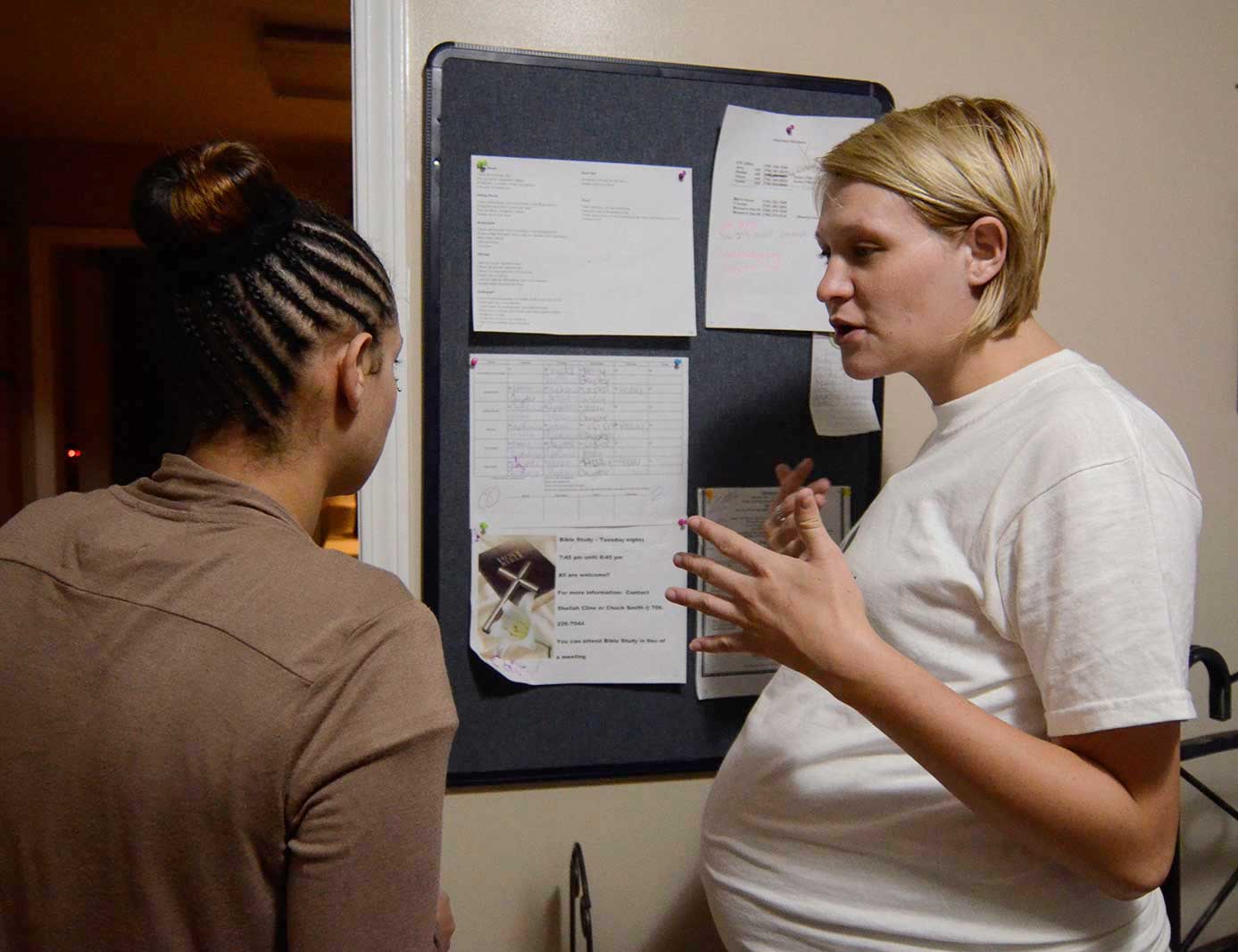
Stephanie, right, shows Dominique the chore list, just hours after Dominique's arrival at the Carter Hope Center.
Yet thanks to luck and genes, Stephanie and Leigh, 28, have glowing complexions and gleaming hair although each has been drinking since the age of 10. Leigh, who comes from an upper middle-class family, is almost the opposite of Stephanie in every way. Where Stephanie is bubbly and bouncy, Leigh has a more reserved, aristocratic air with high, model-esque cheekbones and brown hair.
Some Carter women refer to the duo as “staff pets,” convinced that good looks translate into preferential treatment. College-educated Leigh, the daughter of a prominent minister and a medical professional, concedes that her good looks once helped her persuade police that she had no idea her live-in boyfriend was a drug dealer — while she sat at a kitchen table piled high with heroin-filled baggies.
But like the other Carter rehab women, Stephanie and Leigh are fighting for more than their lives; they’re fighting for their children. Leigh’s son is staying with her parents so she could get herself into rehab. Leigh says the father has never been involved in their son’s life.
In fact, all the women at Carter are mothers who say they want to break their addictions for their children. Most won’t be able. Carter’s grim statistics show that 67 percent of its patients will fail rehab. That 33 percent success rate is much better than most AA programs. According to a 20-year study released this month, AA nationwide scores about a 10 percent success rate.
Carter patients must follow AA’s 12 steps, but some recent studies have sparked a hot debate in the medical community on whether the steps need to be altered for women. At the Center for Gender and Justice in La Jolla, Calif., co-director Stephanie Covington studied how gender differences affect alcoholism. She noted that nationwide most women in rehab are mothers. Motherhood is a key part of a woman’s identity and how society judges her, Covington says, which adds stress to females in rehab. She did not find that fatherhood exerts similar stress on male addicts.
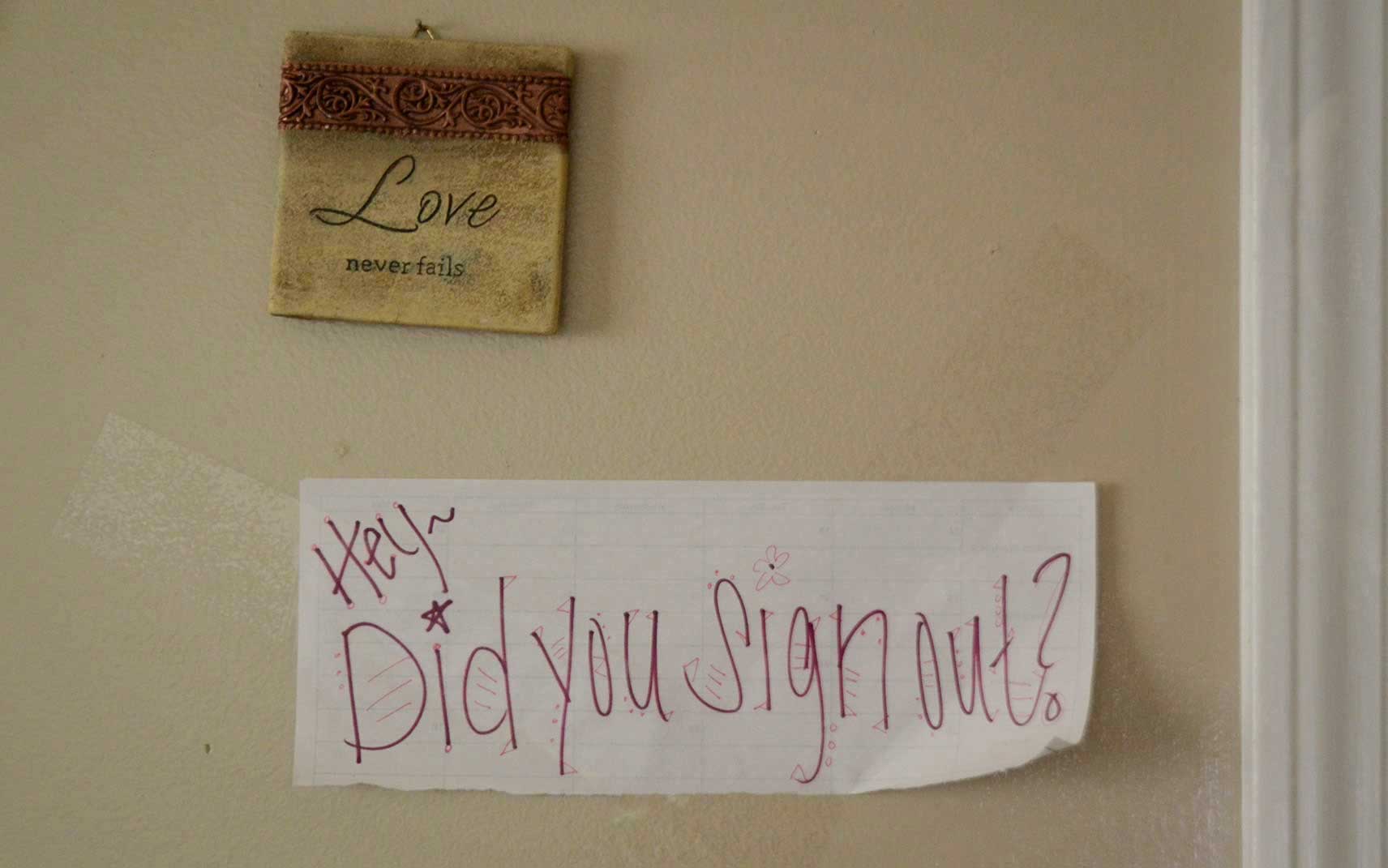
A sign beside the front door reminds residents to sign out before leaving.
Covington believes a couple of AA’s steps actually make it harder for the average female alcoholic to kick her addiction. In Step 2, the addict must acknowledge that only a power greater than herself can restore her to sanity. In Step 3, she makes the decision to turn her will and her life “over to the care of God as we understood him.” Covington argues that those steps do not make a battered, insecure woman feel empowered enough to buck peer pressure to drink or take responsibility for her behavior.
Smith disagrees emphatically, arguing that belief in God is not necessary to success. God or the higher power can be a sound moral compass or the sort of caring self-help group AA tries to foster, he says. Bonding with such a group can be a major step for an addict, Smith says.
The Carter Center is intimately familiar with the statistical casualties that litter the road to rehab. Three weeks after the poetic resident recites her “Mr. Death” poem and tearfully thanks her Carter housemates for saving her life, she relapses so badly she is removed from the program. A few weeks after she leaves, another woman at Carter spots her working as a truck stop prostitute to pay for drinks; such women are dubbed “lot lizards.”
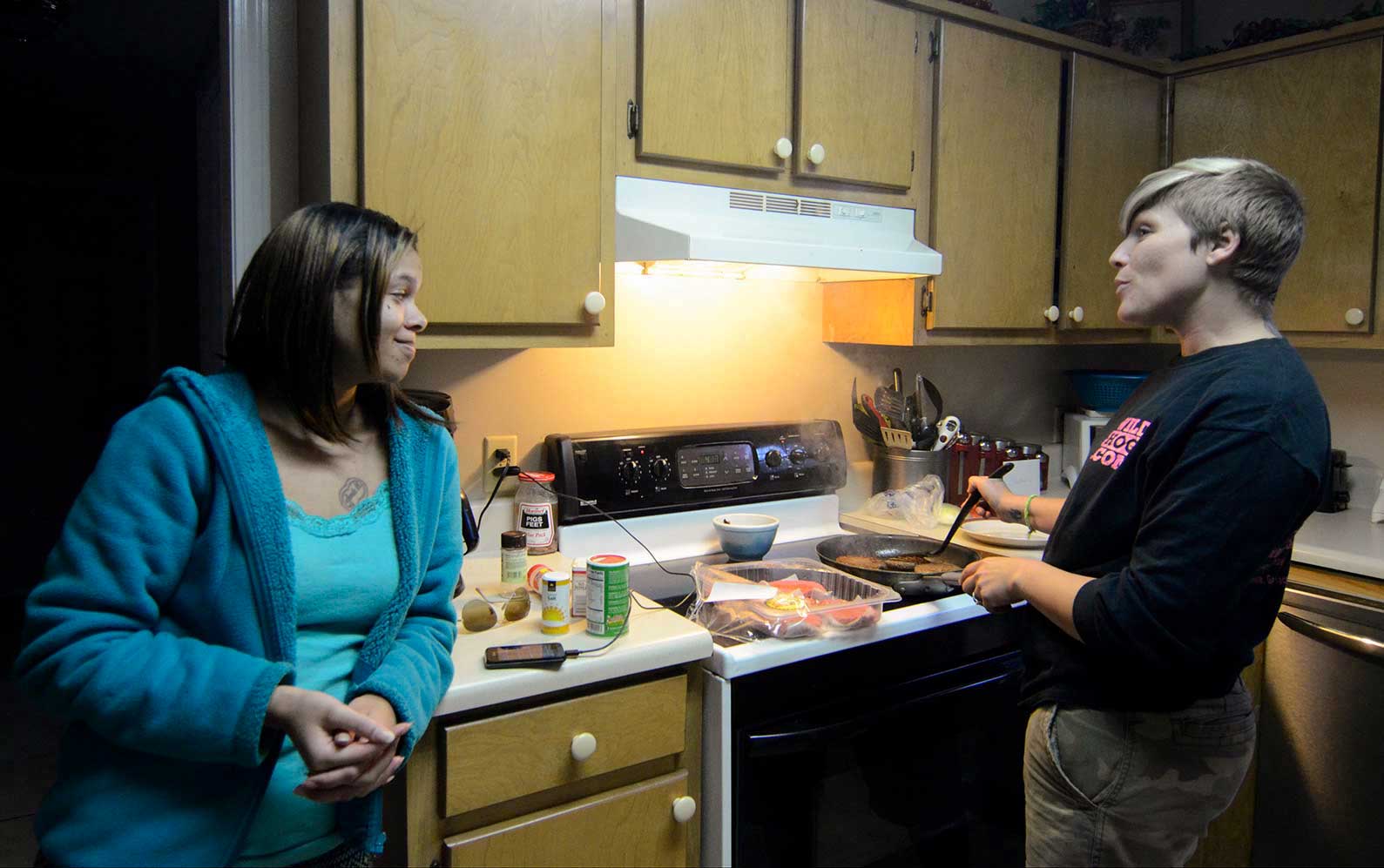
Brooke, right cooks hamburgers in the Carter Hope Center as Dominique looks on.
“That should prove addiction isn’t about stupid women wanting to party all the time,” remarks Renata, who is in her 50s, a year sober and close to completing rehab at Carter. “No one would choose a lot lizard’s life just so they can drink.”
Stephanie and Leigh are intelligent. They know good looks can’t protect women from danger. Leigh, for example, began drinking when a teenage boy raped her. Beauty will not save them from addiction, and it will be no help if Mr. Death comes calling.
Stephanie’s mother had addiction problems, and Stephanie began caring for needy adults when she was in kindergarten. Her dad left when she was a toddler. She, her older sister, kid brother, aunt and mother lived on her grandparents’ farm in Murray County, Ga., along with Spud, her uncle who was born with a disabling muscle disease that left him unable to walk.
“The grownups gave him that name because of his tiny arms and legs and body shaped round like a potato,” she recalls fondly. “Doctors said he would die when he was a child, but he lived to be 26. He was so kind and a real jokester. My job was to wake him up, help comb his hair and get through the day. He would have long conversations with me.
“Everyone else was so busy. My Pawpaw and Grandma worked at factories all day, lots of double shifts. Then they would come home and work in two acres of fields at night, tending the okra, tomatoes, squash, strawberries, watermelons, cantaloupes and green beans. We were so poor, we didn’t eat much that we couldn’t grow out of our own ground.”
One morning, she found Spud gasping for air and she screamed for help. “And my uncle died while I was still on the hall floor, before I could say goodbye,” she says.
When she was still in elementary school, her older sister was badly injured and in a coma after a car accident. Stephanie cared for her until she recovered and, about that time, started sneaking drinks of beer and whiskey she found in the house.
“It didn’t taste good, but I noticed it helped my grandparents feel better when worries got them down,” she explains.
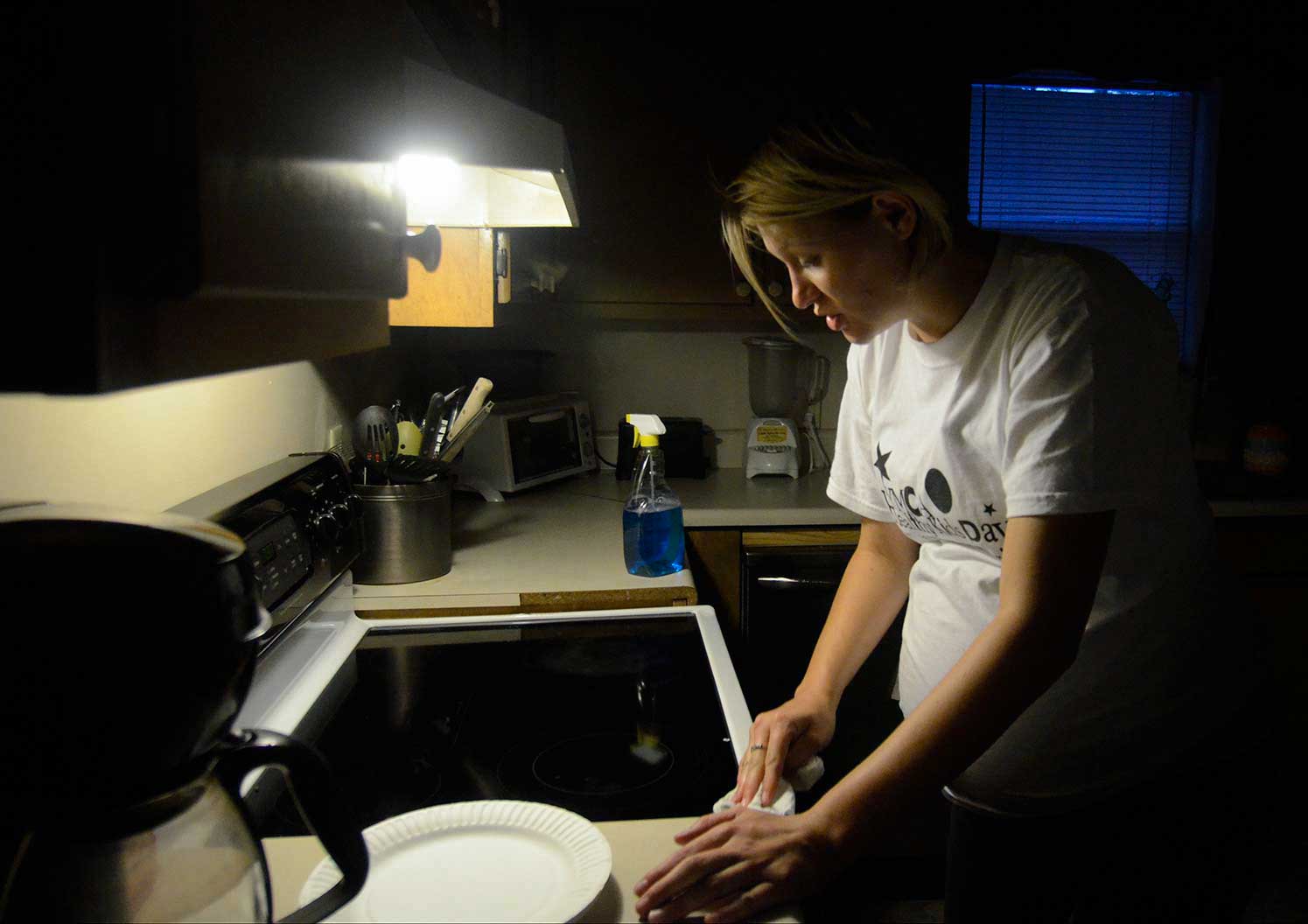
Stephanie does her chores at the Carter Hope Center.
She was in middle school when her mother’s drinking and drug problems prompted social workers to remove her from the home. She went to live with her paternal grandmother, an accountant who was a loyal member of the Red Hat Society, a club for high-spirited older women. She took Stephanie to lunch at Chelsea’s, a restaurant in a Victorian mansion in downtown Dalton, and bought her storybooks. She provided stability and inspiration, and Stephanie did not feel the urge to sneak drinks.
But when Stephanie was ending her sophomore year in high school, social workers returned her to her mother, who was now sober and clean. That same year she was selected as a runner-up in the school’s Homecoming Queen contest. The next year, she fell hard for Justin. They were still dating in her senior year when she found out she was pregnant.
“I had just won an academic scholarship for college. It felt like I lost it as soon as I won it. … I had wanted to study child psychology,” she says wistfully. “Landon was 3 months old when I walked across the stage to get my high school diploma.”
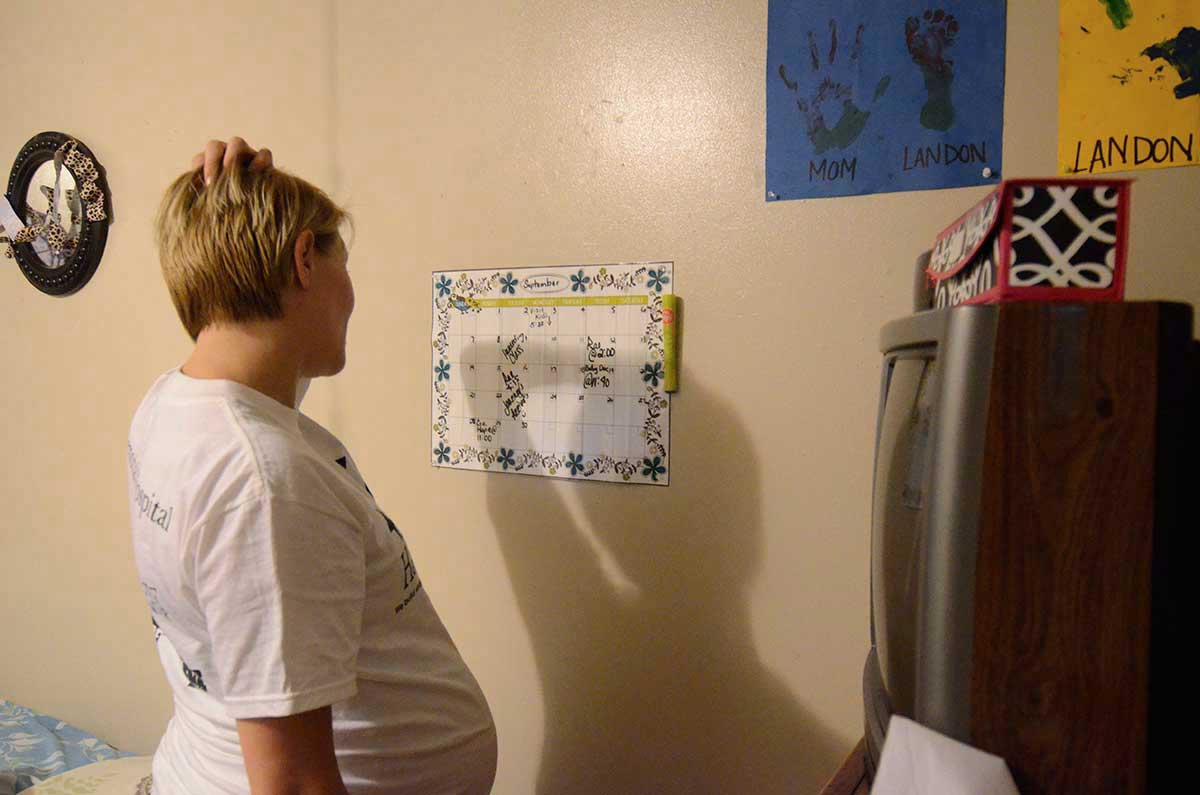
Stephanie checks her appointment calendar in her room.
Landon’s birth was terrible. She almost died during childbirth when complications arose, then she was in terrible pain for days. Postpartum depression was so severe doctors gave her painkillers and anti-depressants. She insists she could always control her drinking as a teenager, but says she felt immediately hooked on pills. When her prescriptions tapped out, she went to drug dealers’ houses to get more. Her mother — a delicate brunette — would physically snatch her out of dealers’ homes.
“I would drive to one of her idiot drug dealer friend’s houses and find her there and drag her out by the hair,” says her mom, Tammi, brushing tears from her eyes. “She would be back the next week. Once I was so mad, I picked up a shovel and broke the windows on the dealer’s house.”
Before Stephanie met Justin, he drank socially but didn’t take drugs. Stephanie changed that.
“I asked him to try pills with me,” she says. “I wanted company. I didn’t want to be addicted alone. I was mad at him because I was so unhappy with how my life was. When I look back now, there was no logic to how I acted.”
After high school, Justin found a landscaping job that paid their expenses — if they were frugal and careful. Incredibly, although it was clear Stephanie needed help with her own depression and addiction, her friends — also addicts — would dump their children at her tiny apartment, asking her to babysit. She wasn’t working, and taking pills was her main escape from her sadness over what her life had become. When she headed out to find more drugs, she often took Landon with her.
“I would leave Landon on the front porches and told him to wait for me and he would cry, he was so scared,” she remembers, tears spilling through her eyelashes. “The most horrible thing I did was tell him to stop crying and be a little man. He would wait in the dark, trying not to cry. I don’t know if he will forgive me. I wonder sometimes if he loves me.”
When an addict looks back on the past, she can describe actions accurately but often has trouble describing what she felt at the time. It could be memory loss; addiction experts say addiction rewires the brain so effectively, an addict is not seeing or feeling the same way sober as she did when she was frequently stoned or drunk.
“I remember doing that to Landon, and I remember at the time it seemed so natural; I can’t explain why it didn’t seem terrible because I feel that and know it now,” Stephanie says.
Justin lost his job the same day Stephanie discovered she was pregnant with twins. They moved into her childhood home with her grandparents. She was able to get sober for the pregnancy by smoking cigarettes. “Therapists call it ‘cross addiction,’ swapping a less-harmful addiction for one that can kill you,” she explains.
The twins were another difficult birth, resulting in more painkiller prescriptions, which led to friends with more dangerous problems.
“I started using meth,” she says. “It was faster than painkillers.”
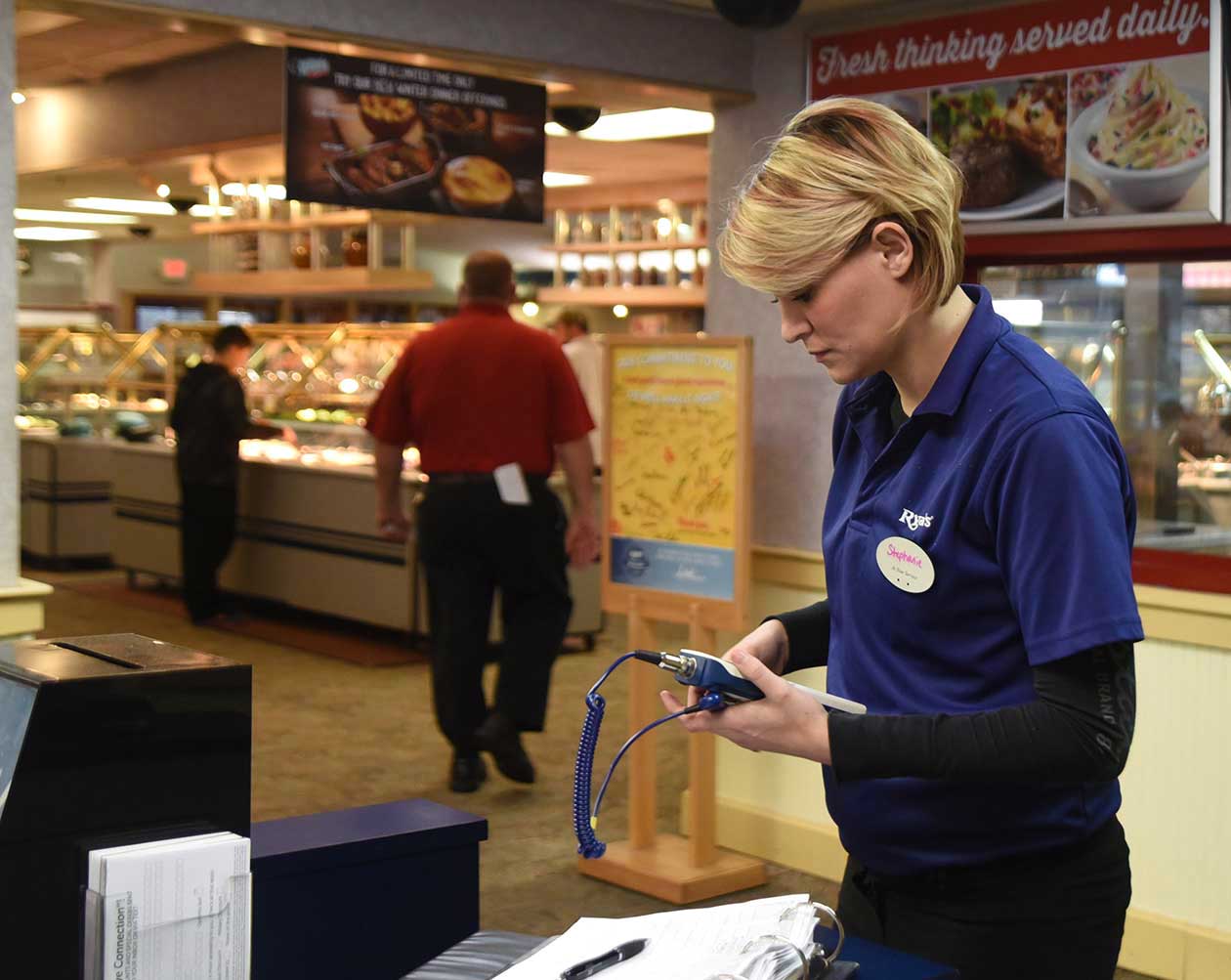
Stephanie works at the Ryan's in Dalton, Ga.
Stephanie remembers picking fights with Justin because she was so depressed about their future prospects. Justin would take Landon and the twins outside when the drug-fueled atmosphere inside the home got too tense.
“Then he started disappearing for days to get away from me, so my mom started hating him for leaving me alone,” she says sadly. “It wasn’t fair. But I was her daughter and she stood by me. Life was a mess back then.”
Since then, Justin has entered an outpatient rehab program and is drug tested regularly at home. He proudly texted Stephanie a few weeks ago when his boss took his photo for an ID badge; the act made the job feel solid. They are not married, but now that Stephanie has landed her first job — as a cashier at Kroger — they are both paying child support to the foster care system. Like all the women in Carter rehab, Stephanie is terrified of a relapse, which research indicates can be much more severe physically and neurologically for women.
When a female addict relapses, drugs and alcohol hit her faster and harder than a relapsing male addict, according to the Substance Abuse and Mental Health Services Administration. Doctors named the phenomenon “telescoping.”
“For women, a relapse is like a scratched DVD; booze or drugs take you back to the last place you were when you were drunk or stoned and using constantly,” explains 26-year-old Amanda, Stephanie’s housemate at the Carter Center. “It’s usually not a gradual slide like it can be for men.”
Amanda nods toward a bandage on her right arm. “I hurt myself on my auto factory job, but if I drink a beer to numb the pain, I’d wake up a few days later in jail, trying to talk myself out of suicide. That’s what happened the last time I was drunk.”
Stephanie seems determined to live her life as an honorable person; no lying, no secrets. But Journey’s birth in the fall will be by Cesarean section and she worries that afterwards she’ll need painkillers, triggering her addiction. Whatever the future holds, she vows to complete AA’s Steps 8 and 9 fully — she must remember every person her addiction has harmed and make amends. Some addicts make amends by apologizing and proving they are a new person, others by repaying stolen money.
But she knows a 5-year-old boy who may not accept her apologies.
Stephanie talks about life at the Carter Hope Center and what it might be like when she goes home.
Boston University neuropsychology researcher Susan Ruiz was conducting MRI brain scans last year on male and female recovering alcoholics by showing them provocative images — sexy, violent, beautiful, thrilling — with pictures of booze as part of the mix. She recorded which areas of the brain lit up with activity.
A woman who had been sober 17 years was watching the flow of images when suddenly she gasped, “Get me out of here!” The woman was shaking as she said pictures of beer had triggered a craving more powerful than she thought she would feel again.
Any non-addict may wonder what kind of high a drink or drug could deliver to make someone become an addict and give up their family, homes and lives to obtain. Neurobiologists say an addict’s high is better than sex with a dream lover, better than bingeing on the world’s best candy, better than holding one’s newborn baby; basically better than any feeling that exists in the real world. But it’s all a lie because the feeling is artificially manufactured.
“Alcohol and opiates rewire an addict’s brain. Think of the brain as a city, and the addiction shuts down essential highways and destroys crucial lines of communication,” explains Pingenot, who teaches UTC nursing students. “Roads open where none should be. Addiction shortcuts the connection from the brain’s reward center with the flight-or-fight portion of the brain, so sobriety creates a life-or-death panic in the addict.”
Carter graduates tend to fear relapse so deeply, they rent apartments or tiny houses on the streets encircling the center’s mansion, spending years in the area because the proximity comforts them.
The Center for Gender and Justice documented one dramatic difference between male and female alcoholics — 74 percent of female alcoholics suffered sexual abuse or rape before they became addicted; such abuse may have a huge impact on what sort of rehab a female addict needs. Sexual abuse is not the norm for men in rehab.
After the baby shower, Leigh heads back to the Carter bungalows. When she arrives, a cuddly stray puppy with black and white spots waits on the big porch. He has adopted the ladies, and they dote on him. The women don’t decorate their bedrooms with art or mementos, so the puppy does quite a bit to make the house feel homey.
Leigh quit her Georgia social worker job more than two years ago when she decided her drinking made it impossible for her to focus on a case file’s details.
“I really loved that work, even when it was sad, because I felt like I was protecting children and helping families,” she says. “I would never want to put anyone at risk because I wasn’t focused.”
Her friends wondered how a young woman from such an accomplished, respected family could ever develop an addiction. She first began drinking secretly at age 10, after she was raped by an older boy in her upscale neighborhood. When she retraces her life, she never blames anyone but herself. She never told her parents about the rape; she thought they just knew because they were so smart. And, because you didn’t talk about unpleasant things in her home, she never asked.
“You know how as a kid you think your parents are so powerful and all-knowing?” she asks. “We lived in a very nice, safe neighborhood. My family valued positive feelings. I drank to numb my sad feelings and drank when I was scared.”
She continued to make good grades, go to church and didn’t get drunk until she was 14 on a date with an older boy whose family was friendly with hers. He bought liquor for her, she says, and when she got drunk, she was raped.
“Then I did believe there was something wrong with me that made guys think it was OK to treat me badly,” she says, heaving a sigh. “I decided I would need to have a protector always. I dated older guys who promised to take care of me and who would get drugs and alcohol for me when I needed to feel better.”
Like Leigh, many female addicts make a family of their own with the worst possible choices in men — drug dealers or drunks who will never complain when the women self-medicate with booze or pills. Leigh’s college boyfriend was a dealer who gave her heroin for the first time and she got hooked. But she hid her addictions so well, she got a live-in nanny’s job with two doctors. The husband would give her a 12 pack of beer as a weekend treat. But after graduating college with a bachelor’s in social work, she found out how dangerous a drug-peddling protector can be.
A dealer in the same Georgia college town thought her boyfriend had cheated him. He kidnapped Leigh, drugged her. For the next three days, he smothered or choked her until she blacked out, then waited until she regained consciousness to do it again. She can’t remember if he wanted information or was torturing her for fun. At one point, she must have been screaming because neighbors called the police, who rescued her.
Leigh says the dealer released her when he heard the sirens, but police spotted her leaving the home. Police officers familiar with the situation say the man was arrested on drug possession charges. Leigh, who has no felony convictions, did not press charges. She was worried a police investigation might drag her drug history into daylight.
“When I have nightmares about that night, I wake up gasping for air,” she says.
Dropping the drug-dealer boyfriend, she sought sanctuary and a normal life, landing a good job as a social worker. But she got pregnant. The baby’s father was not in love with her, so she raised her son on her own. Outwardly she looked successful, but her heroin addiction was costing her at least $1,000 a week.
“I used to be proud that I never stole money or robbed a liquor store to pay for my drugs, but I realize that is denial because what I did was just as bad,” she says. “I would tell family or friends that I was trying to get clean, but I needed money to enter rehab. I was very convincing. They gave me money, and I would spend it on drugs.
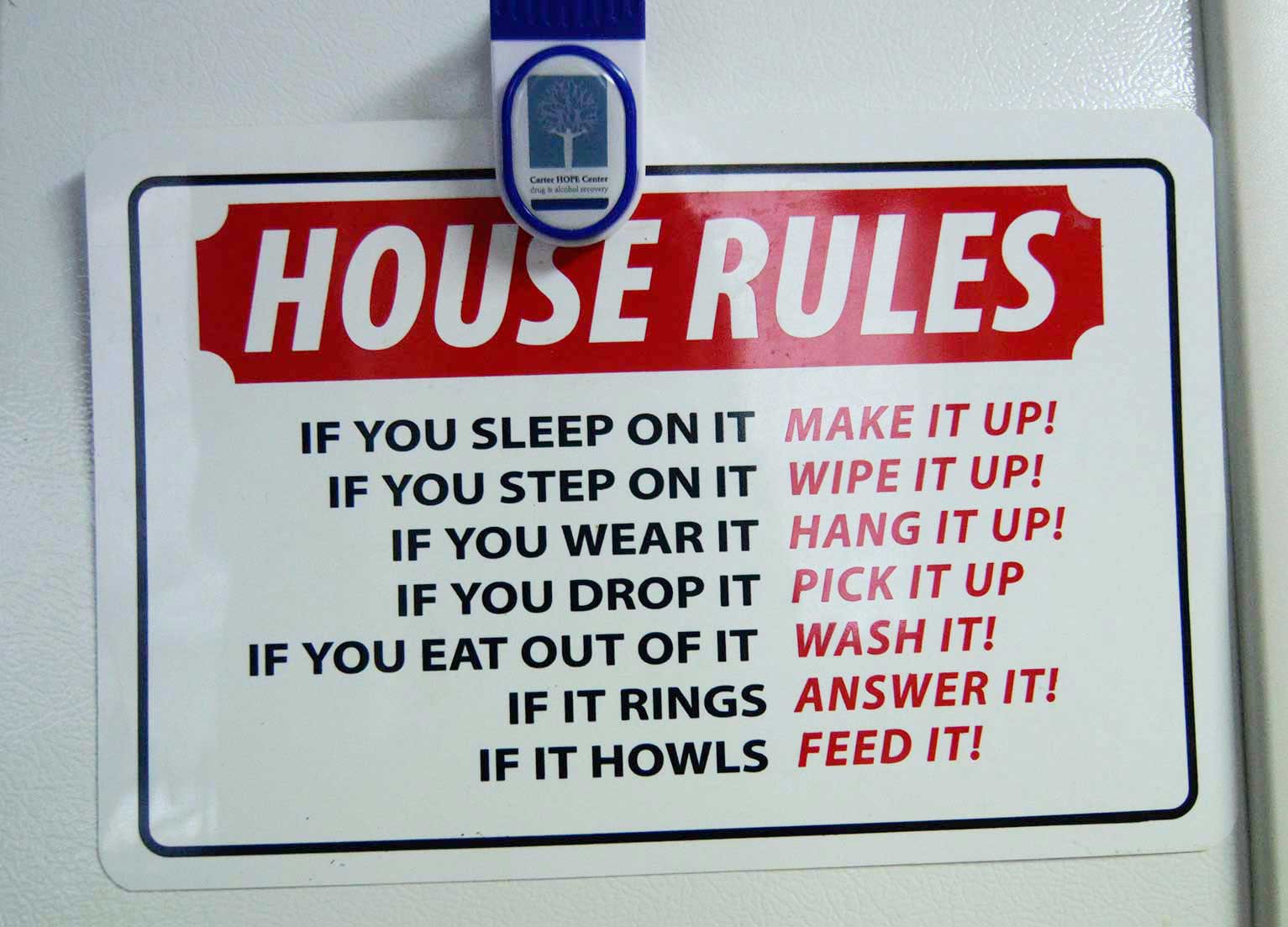
A list of house rules is posted on the refrigerator at the house.
“But something had changed in me after the kidnapping. Heroin and alcohol didn’t make me feel stronger or steadier like they used to any more.”
She was accepted at Carter Hope and got a job at a family-owned bookstore to pay her weekly bill at the center. She told her son she needed to get well so she could be a good mother. Her parents cared for him while she was in rehab.
“I’m 128 days sober,” Leigh says. “I asked for early graduation because Shaw Industries offered me a job in human resources that I would need to start in about a month. I need to find an apartment for my son and me.”
She graduated from Carter early and, a few weeks later, married a former addict she met while in Carter, a much older man. Her friends say the relationship mirrors her pattern of finding an older protector, the difference is that this one successfully completed rehab. She turned down the Shaw job to work at home, helping her husband list the cars he repairs and sells on Craigslist. She says she finally feels happy and, for the first time ever, safe.
Stephanie’s perfect baby girl is born on a sunshiny, breezy day. Her family and Justin’s are in the hospital room, as are a woman from the Carter home and some of Stephanie’s high school friends. When guys from the bikers’ AA group arrive, they all form a prayer circle around the bed. Stephanie’s fair skin is whiter than the sheets and she struggles to be alert and a gracious hostess.
Stephanie’s group home housemate, Crystal, has been there since before dawn to greet Journey. She accurately describes herself as the group home “mother hen and God’s narc,” meaning she cheers the younger women on and consoles them but will report drug use if she suspects it.
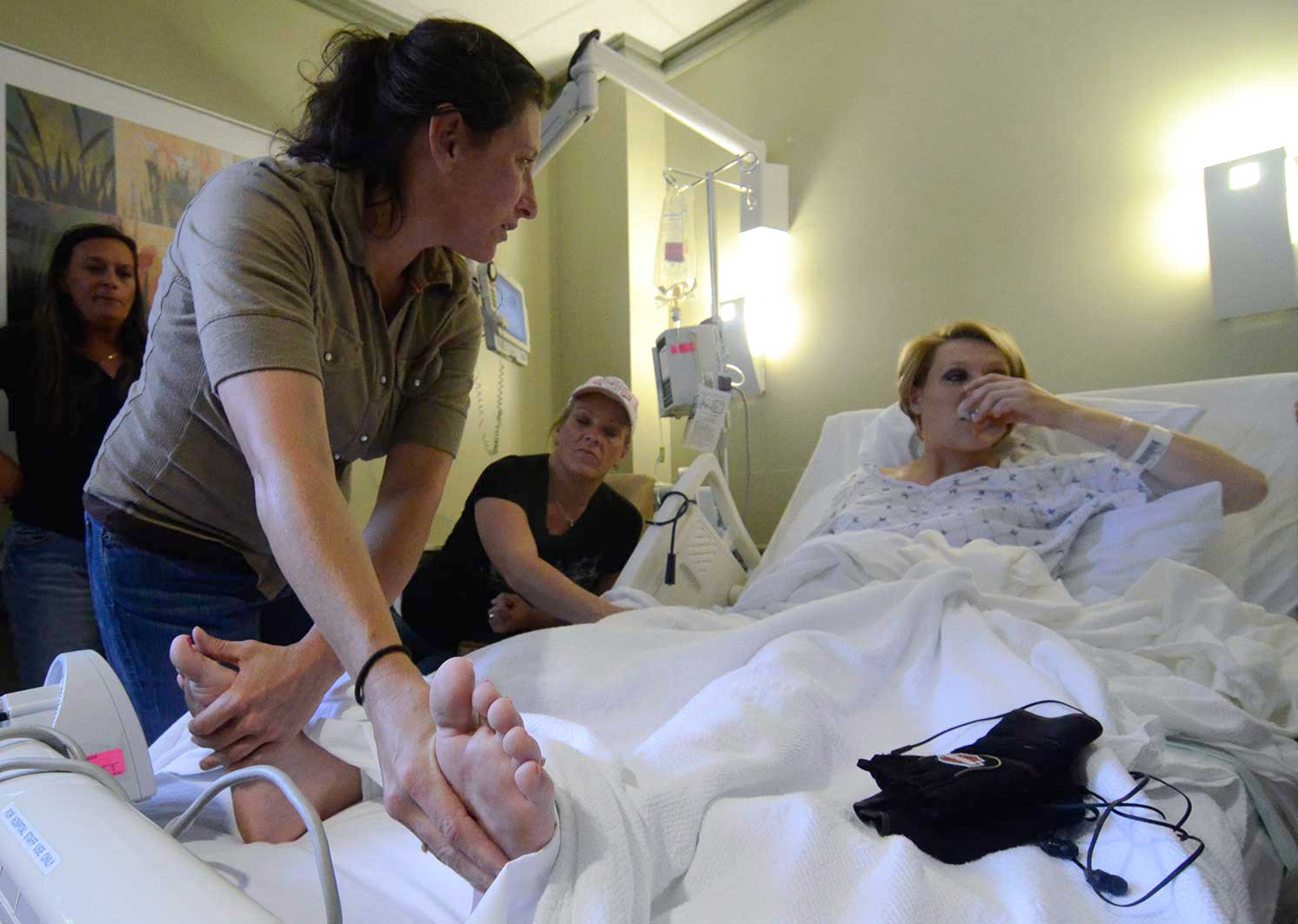
Stephanie's mother rubs her feet after her C-Section to deliver Journey. Terri, left, and Crystal look on.
But something is wrong with Stephanie. Color drains from her face and her forehead is beaded with sweat. A well-wisher rushes to fetch her a cup of crushed ice, but she is too weak to keep the cup at her lips. Justin sits at her side, chatting with buddies, but Crystal is worried. She forms another prayer circle.
“God, we know we are sinners but ask for mercy because by your stripes we were healed; please strengthen this new mother,” Crystal prays. As Crystal is saying “amen,” the nurse checks Stephanie’s vital signs.
“She’s bleeding out,” the nurse’s alarmed voice cuts through the chatter. “We need to clear the room!” the nurse yells, herding the crowd of friends and relatives out as orderlies rush in with a crash cart. The medical staff discovers that doctors nicked a vein during the Cesarean. After several hours, her family is told her life is safe, but Stephanie’s ordeal is not over.
A few hours after Journey is born, Stephanie has time to dress her in a charming onesie she got from the baby shower. But she never got the chance to try all the clothes on her new baby. While she is still recovering at the hospital, the Division of Family and Children Services comes and takes Journey to foster care. The case workers did not trust Stephanie’s plan to let a drug-free, non-drinking relative care for the baby.
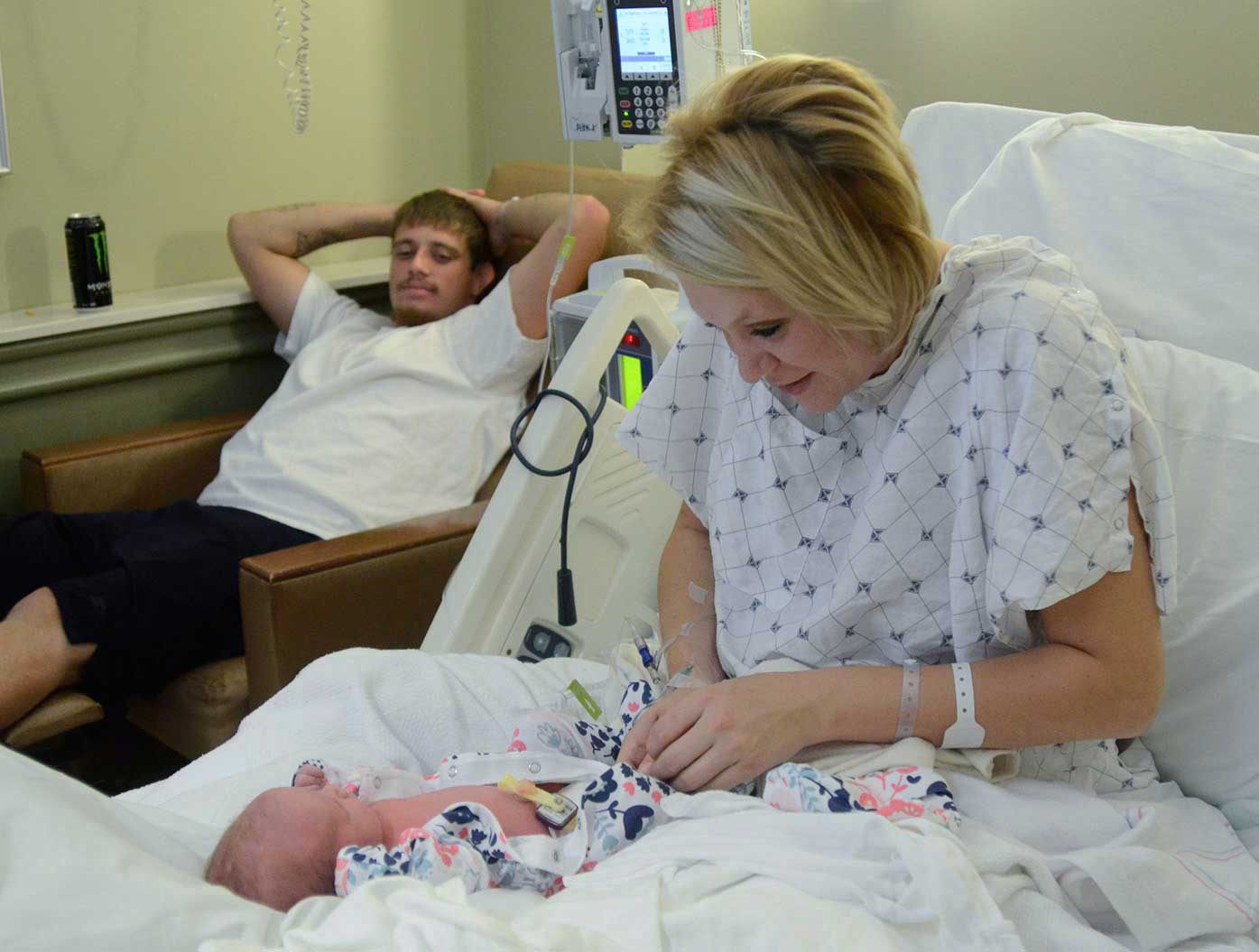
Stephanie dresses Journey as Justin looks on in her Hamilton Medical Center room.
“They sent two police officers along with the case worker and I asked them all if they thought that was really necessary,” Stephanie said, clearly depressed.
A week later, Stephanie is back in the Carter home. Maybe if her energy wasn’t so depleted, she would have been able to put up a fight against the young woman the other patients nicknamed Mean Girl.
MG arrives on a Wednesday night. Her mother wanders through the group home, a pot full of stew tucked under her arm. She wants her daughter to eat, but MG is on the porch; she and some friends who accompanied her chat about getting drunk. Her mother sits inside the home, talking to MG’s new housemates.
“I was a former addict; I kicked the habit cold turkey so I know my daughter can do this,” she says, clutching the stewpot to her chest like a baby.
MG bonds immediately with Dominique, a 20-year-old single mom from Mississippi who gave birth to her child while the father was hiding inside the hospital delivery room as police searched for him. He went to jail and Dominique dumped him.
Dominique impressed everyone with her poise on the first day at the Carter Center. She has convinced an attorney to help get her juvenile record expunged so she can continue taking community college classes to be a teacher’s aide. She lands a job at Wendy’s her first week at Carter and never forgets to do her daily housekeeping chores. She is the polar opposite of MG, who one housemate describes as a “sofa slug” that spends hours watching TV.
But once Dominique befriends MG, she joins her in blowing off required group sessions to listen to rap music and ridicules the program. Dominique crosses a line when she falls weeks behind in her rent then brags about spending more than $100 on body piercings. Director Smith sends her back to her mom in Mississippi.
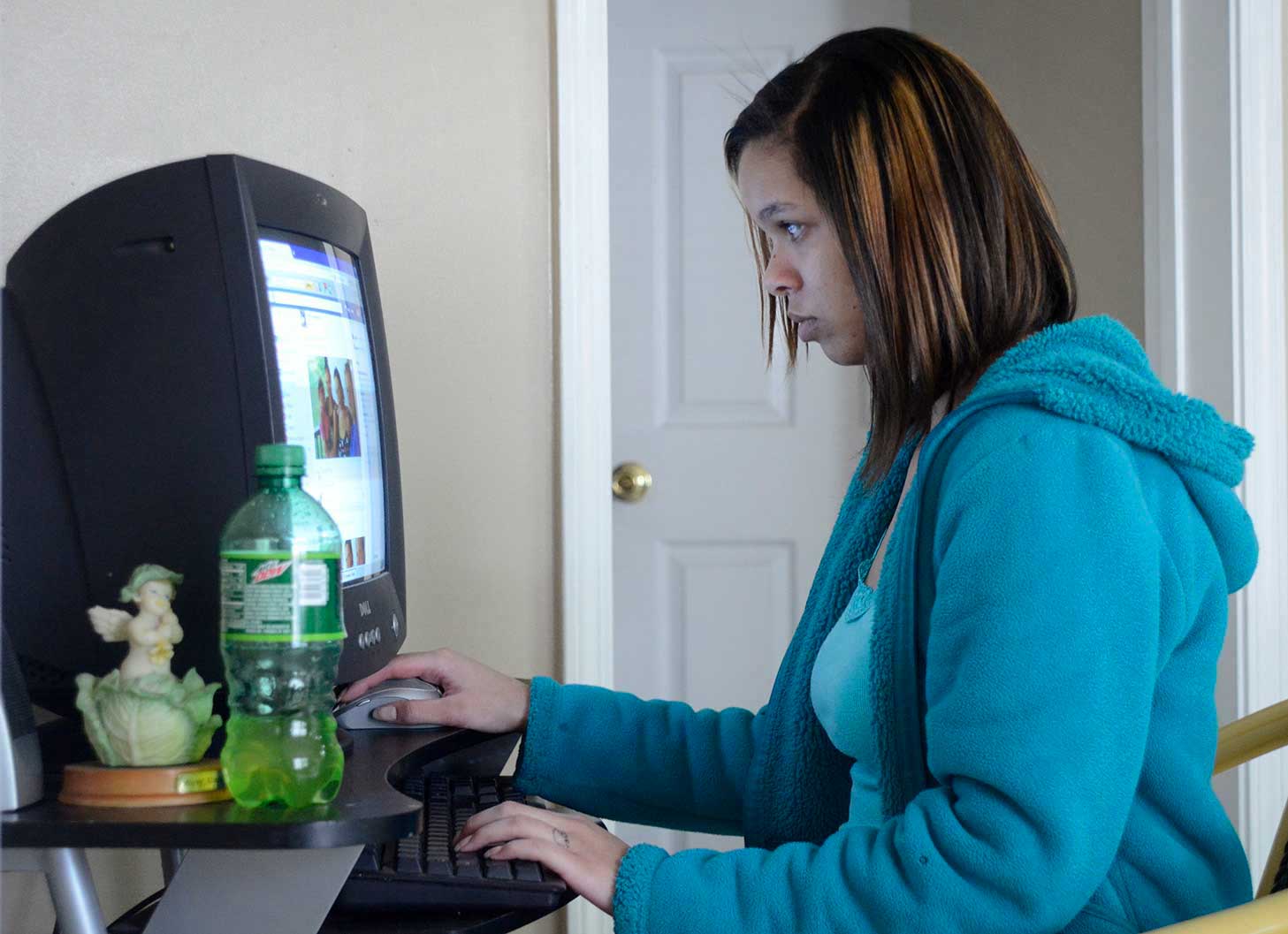
Dominique checks Facebook on the computer in the Carter Hope Center.
MG attends meetings to avoid getting tossed out, but sits silently through group self-help sessions or gives deliberately awful advice. And she zeroes in on Stephanie for companionship. Stephanie didn’t care for MG from the start.
“I didn’t like her and she was not even interesting or smart to talk to,” Stephanie says. “But she would start her conversations by telling me she was scared she would relapse and needed me to help her.”
Unlike a session guided by a licensed psychologist, AA groups are self-help and depend on honest, thoughtful reactions from participants. If a rehabber is being evasive or blaming someone else for her flaws, a good group will call BS on her, applaud her achievements and share good advice. But many of Carter’s female patients bluntly say they are not used to trusting or liking other women, an obstacle for group therapy.
“Women in general don’t treat each other well; that attitude can be almost pathological in group sessions,” UTC’s Pingenot explains. “Women are socialized to be nurturing, which helps them spot others’ insecurities. When women aren’t accustomed to developing direct power in the workplace or family, they succeed through social empowerment. The bright side of that approach is friendliness and team-building. The dark side is backstabbing and disrespectful confrontation. Healthy confrontation is crucial in rehab, because denial and rationalization among addicts is so constant and difficult to penetrate.”
At Carter, a resident tells Smith that MG and another young female patient are using drugs. Smith orders drug tests for everyone in the house. Some rehabbers want to get caught; Carter veterans remember when a drug stash fell out of a girl’s panties during her drug test. But MG is discreet. She begs Stephanie to urinate in the testing cup so MG will have a clean urine sample. Stephanie does. But Smith is suspicious when MG tests clean. He orders another round of surprise drug tests a week later. Stephanie supplies clean urine again.
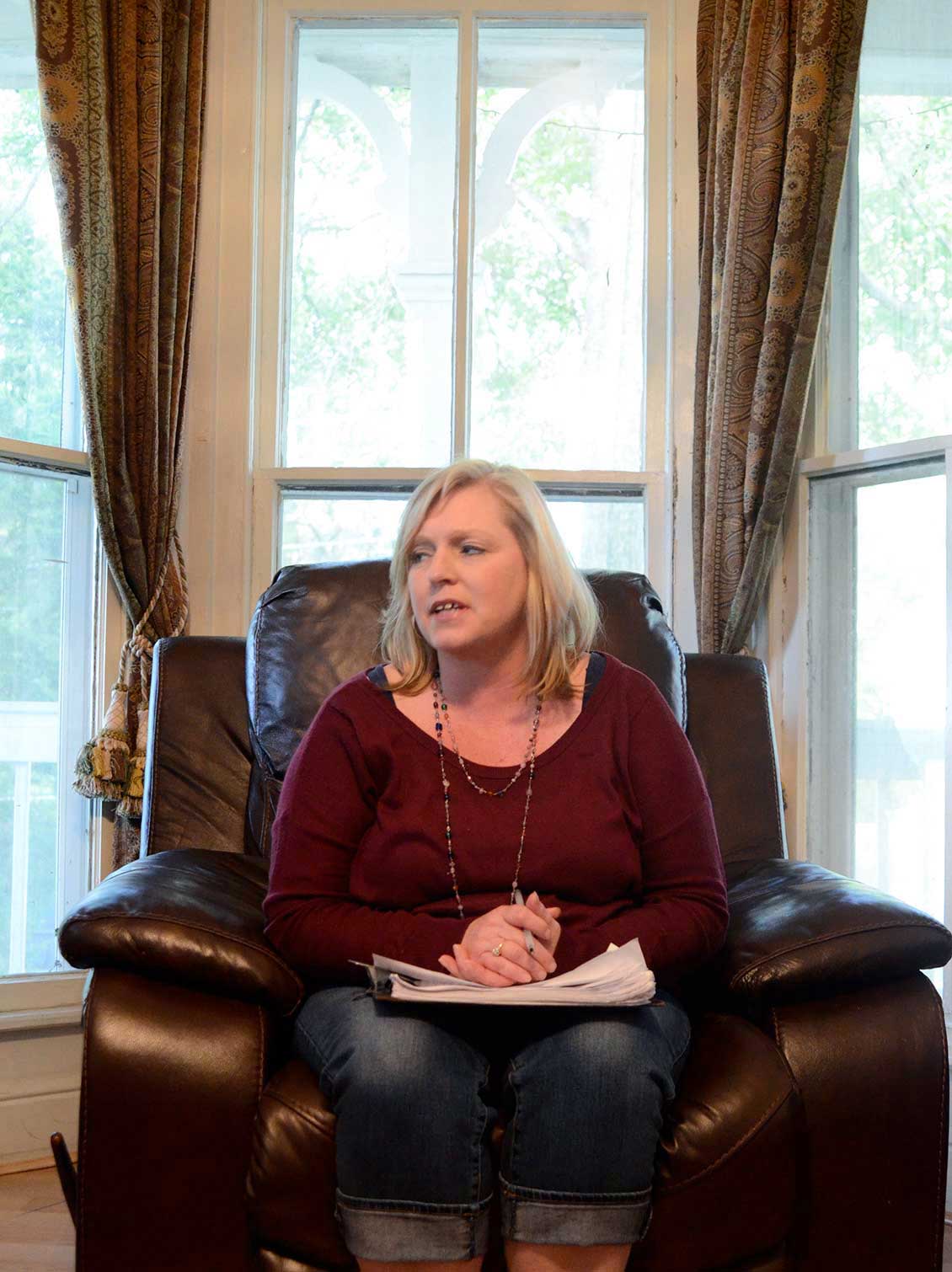
Sheilah, a former addict who went back to college to become a counselor, leads a session at the Carter Hope Center.
“I don’t know why I did it,” Stephanie says wearily, a week later. “What scared me about her is that she seemed to want everybody else to fail along with her so I figured if I refused, she would accuse me of using drugs to get back at me.”
While all this is going on, Stephanie decides she will never get full-time hours at Kroger so she wins a job at Ryan’s restaurant. She attends church. She doesn’t relapse. Then one night, MG implores Stephanie to accompany her and a boyfriend to an AA meeting downtown. When they get into the van, MG fires up a meth pipe and offers it to Stephanie.
Stephanie takes a hit.
A group home resident tips off Smith about the incident and he orders drug tests for the entire house again; MG and Stephanie’s come back positive. MG is banned immediately. Smith wants to throw Stephanie out, too, but Crystal pleads eloquently on her behalf but Smith is not in the mood for patience. He is especially enraged because he gave Stephanie a “rehab scholarship”; she could not afford rent so she did not have to pay the weekly fee. He feels betrayed.
“Chuck yelled at me to get out of his face when I went up the hill to apologize,” Stephanie recalls, visibly shaking. “I was so scared and couldn’t stop crying.”
As the long day dragged on, Smith thinks about all the progress Stephanie made. He eventually relents and lets her stay.
“She’s on probation,” he says grimly. “She’s required to report the relapse to (Division of Family and Children Services). If she doesn’t do that by tomorrow, we’ll do it for her.
“Look, I understand that when women get closer to getting their children back, sometimes they get scared and shoot themselves in the foot. She told us she was feeling overwhelmed by the idea of working full-time to support four children. So now she’s starting on Step 1 and will have to work her way through the program again. No early graduation.”
What he is too tactful to say is what Stephanie now talks about openly; she is seeing her family and boyfriend for the first time clearly without meth, opiates or beer clouding her vision. And she realizes how alone she may become as she tries to reclaim the maternal bonds, education and security that addiction cost her.
“Now I can see ways I wasn’t honest about my progress,” she says. “I chose a sponsor who goes to my church. She’s nice, but never felt I could tell her everything because I didn’t want someone in my church to think badly of me. I’m getting a new sponsor and a therapist. (Division of Family and Children Services) got a parenting coach for me. I need to learn about being a good parent.”
The extra months in Carter rehab begin to look like a blessing for Stephanie. Relapsing after seven months clean and sober, Stephanie is asking herself tough questions that her housemates and family once worried she was too fragile to confront.
Will she and Justin be able to support four children and find good child care for their kids while they are working? Justin is two years younger than she and, even with a heart of gold, is he mature enough for full-time marriage and child rearing? Someone notes that Justin had posted a joke on his Facebook page about urging the 2-year-old twins to fight each other so he can make a YouTube video of it.
“He would get them psyched up to fight or wrestle each other, but they were laughing and enjoyed it,” Stephanie says hastily. “I know it might be misinterpreted by someone reading it without knowing him. He took it down. He loves his kids completely. But we both need to learn more about parenting.”
Will they get married?
“Everyone asks that, but I think he and I need to think some more about whether that is the right thing to do,” she replies slowly. “This year has been the first time we were both sober and talked to each other deep about the future. We’ll always love each other and be in each other’s lives as parents of four children, and we need to figure out how to give those kids a good life.”
A year before she entered Carter, Stephanie managed to maintain several months of sobriety while Landon and the twins were in foster care. On Mother’s Day, the twins’ foster parents brought the kids to meet her in a park. They played with her sweetly, but they called their foster mother “mommy” repeatedly. She relapsed that night.
Lately, she’s been thinking about what a Carter counselor told her. The counselor successfully completed rehab at Carter and never drank or took drugs again. She went back to school and got certified as a counselor. But one of her daughters did not want to leave her foster family to return to her, and she finally agreed to let the little girl stay with the family that made her happy.
Stephanie sees that story as a possible scenario in her life.
“I hope Landon forgives me, but if he were tell me he wanted to stay with his foster parents, it would break my heart, but I know they are a wonderful couple so I would say ‘yes’ and hope he lets me stay in his life,” Stephanie says, then stops to regain control of her trembling voice. “I’m not just building a life for myself in rehab. I have to build a life for my children, all of them.”
1. Admit we were powerless over alcohol, that our lives had become unmanageable.
2. Came to believe that a power greater than ourselves could restore us to sanity.
3. Made a decision to turn our will and our lives over to the care of God as we understood him.
4. Made a searching and fearless moral inventory of ourselves.
5. Admit to God, to ourselves, and to another human being the exact nature of our wrongs.
6. Were entirely ready to have God remove all these defects of character.
7. Humbly asked him to remove our shortcomings.
8. Made a list of all persons we had harmed and became willing to make amends to them all.
9. Made direct amends to such people wherever possible, except when to do so would injure them or others.
10. Continued to take personal inventory, and when we were wrong, promptly admitted it.
11. Sought through prayer and meditation to improve our conscious contact with God as we understood him, praying only for knowledge of his will for us and the power to carry that out.
12. Having had a spiritual awakening as the result of these steps, we tried to carry this message to alcoholics, and to practice these principles in all our affairs.
Get help
Alcoholics Anonymous in Chattanooga: 423-499-6003
Alcoholics Anonymous in Dalton, Ga.: 706-279-9944
Carter Hope Center: http://www.chcenter.com/
By Lynda Edwards
Photography by Angela Lewis Foster
Design by Sara Jackson
Production by Mary Helen Miller and Maura Friedman and Ken Barrett
About this story
Over the course of five months, Times Free Press staff writer Lynda Edwards and staff photographer Angela Lewis Foster spent dozens of hours with women at the Carter Hope Center rehab facility in Dalton, Ga. The women, all dealing with drug or alcohol addiction and all mothers who'd lost their children to foster care, agreed to tell their stories and be photographed, but asked that their last names be withheld.